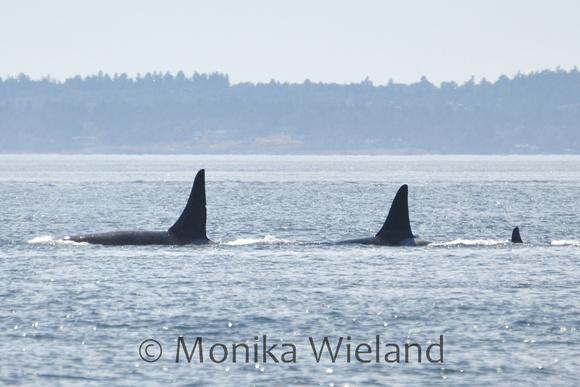Today was one of those days - the kind of day that made me want to live on San Juan Island in the first place. The title of this blog post is rather unoriginal, but it's probably the phrase I most uttered today, so I thought it was appropriate.
We went out to the westside around noon today with word that some whales were heading down from the north. Just as soon as the boats and some distant blows were coming into view to the north of Lime Kiln Lighthouse, we heard some people screaming to the south of us. I turned around and saw a big disturbance in the water just offshore of the rock to the south of me. A few seconds later, just long enough for me to grab my camera but not to adjust any of the settings, this big male orca surfaced just north of me, cruising north towards the other whales heading our direction. Surprise!
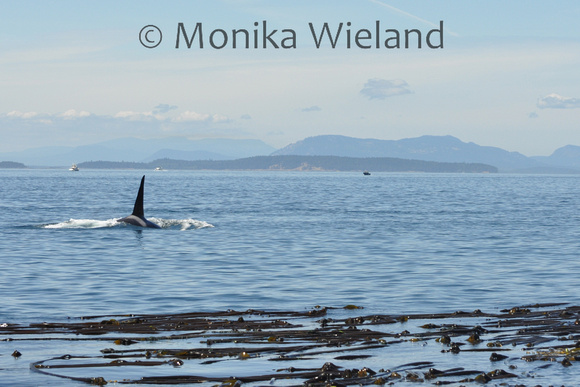 |
| L85 Mystery heads north to meet up with J and K Pod whales |
It was L85 Mystery, and right behind him were the rest of the L12 sub-group. This family group of whales likes to spend a lot of time off the southwest end of San Juan Island, going up and down, up and down, but rarely really committing to going north. They're well known among shore-based whale watchers as the group that just comes into view at Lime Kiln before nearly always turning south again. This afternoon, however, they were interested in going just a little bit further north to meet up with some of their J and K Pod friends. Best of all, as they sped north, they did so very close to shore.
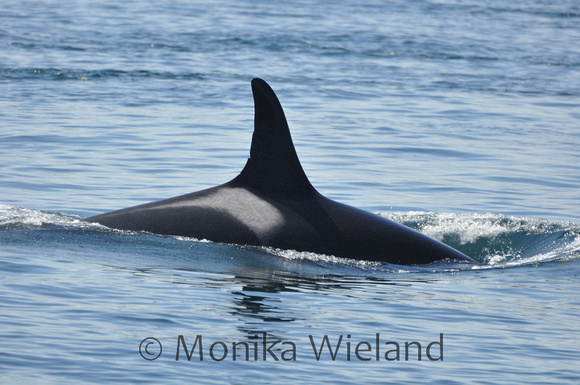 |
| L12 Alexis - the best photo I've ever gotten of this female estimated to be 78 years old. Prints of this photo available here |
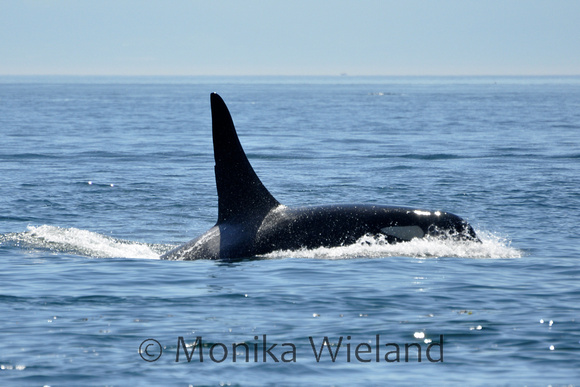 |
| L41 Mega - prints of this photo available here |
The whales all met up just north of the lighthouse, and spent a bit of time milling around before slowly making their way back south. While we were waiting for them to come back, we noticed a very unafraid little bird making its way through all the whale watchers on the rock. It was an immature brown-headed cowbird, and it was totally unfazed by all the human activity. It hopped right between my feet, and perched on my radio sitting with my stuff right next to me:
I've never seen anything quite like it! He even seemed to perk up and get interested as the whales started coming by, but then I must admit I lost track of him as my focus returned to the orcas.
All the male orcas seemed to be grouped up, which was an impressive sight with all those tall dorsal fins. Here's L41 Mega and K25 Scoter, and at least J27 Blackberry and J34 Doublestuf were in there with them, so I suspect the other L12 subgroup males were as well.
This large group of whales, including more than just the males, was a little ways offshore, but they were playful. They were just slowly making their way south, doing some tail-slapping, cartwheeling, upside-down swimming at the surface, logging on the surface, and they threw in a couple of breaches for good measure:
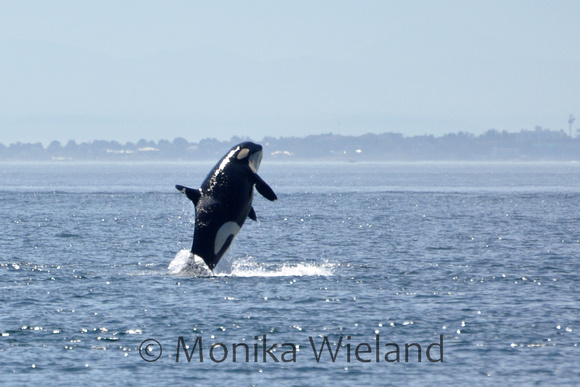 |
| Prints of this photo available here |
Then I noticed two whales that were much closer to shore, and heading right for us. Let me tell you, my favorite feeling in the world is sitting on a rock on the west side of San Juan Island and seeing this - a wild killer whale heading right for you:
 |
| Prints of this photo available here |
It turned out to be J31 Tsuchi and L77 Matia, two female whales ages 16 and 24. I always think it's especially cool to see whales from different pods hanging out together. It's a glimpse into the social lives of these animals outside of their matrilines, with whom they travel with 24/7.
 |
| J31 Tsuchi - prints of this photo available here |
A note on this next photo, to give you an idea of just how close these whales come to the shore - this image is not cropped, and my lens was only zoomed in to 180mm to take it:
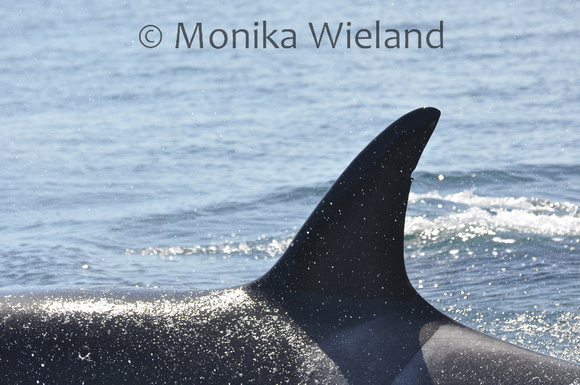 |
| L77 Matia - prints of this photo available here |
So after the L12s had gone north, the L12s, K13s, and half of J-Pod (the J11s, J22s, and J17s) came back south. Where was the rest of J-Pod? They were coming down San Juan Channel past Friday Harbor, which gave us enough time to drive down to Cattle Point to see them down there. We got there a little ahead of the whales, and while waiting for them we saw lots of other wildlife, including a single male Steller sea lion over on Whale Rocks.
I was also watching a single rhinoceros auklet diving on a school of small fish. Every time it dove, bait fish would start jumping at the surface, and a single glaucous-winged gull was sitting on the water nearby and taking advantage of this feeding opportunity. As we watched, more gulls came in, and then more auklets, and then some pelagic cormorants, and some Heermann's gulls, and before we knew it a nice bait ball had formed.
Then the whales came into view passing Cape San Juan close to shore, heading south towards where we were on the rocks in Cattle Pass. I was excited they were on "our" side of the channel, but I know they usually veer out and go around Goose Island. In fact, I heard some people commenting on the radio that they had never seen them go inside of Goose Island. Well, if you keep watching these whales, every so often you are going to see them do something you've never seen them do before, and today was one of those days! They swam through the San Juan Island side of Goose Island!
They continued swimming close to shore as they passed us at Cattle Point, and since they were active and surfacing a lot I was able to find each and every whale from the J2, J14, and J16 family groups in my photos. The lighting was also perfect, much better than the harsh lighting off the lighthouse earlier in the afternoon. Here's J2 Granny with a Vancouver Whale Watch boat in the background:
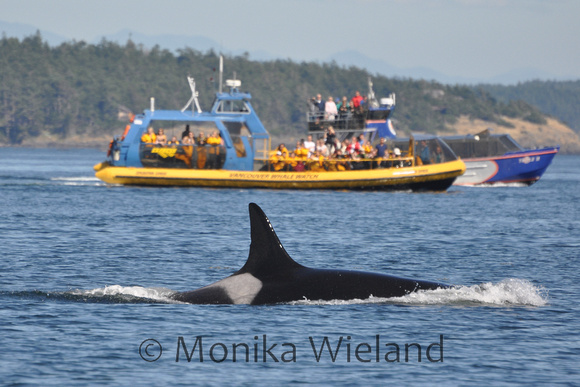 |
| Prints of this photo available here |
J26 Mike was looking good - I remember seeing him before he was even a sprouter male, and now he's so huge!
 |
| J26 Mike - prints of this photo available here |
He must have been feeling good, too - look at that tail slap!
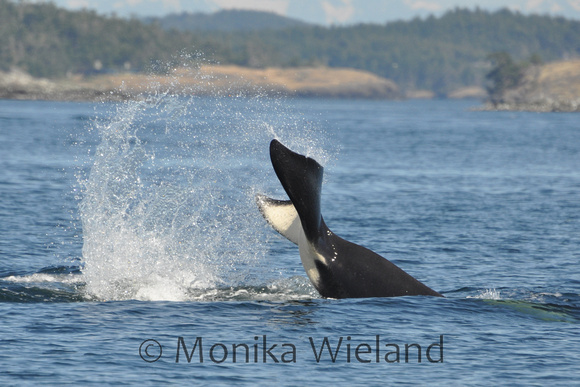 |
| Tail slap by J26 Mike - prints of this photo available here |
The whales don't travel through San Juan Channel very often, but when they do I've never seen them kelping at Cattle Pass. That's what some of them were doing today, though! Here's J16 Slick, Mike's mom, with kelp draped on her dorsal fin:
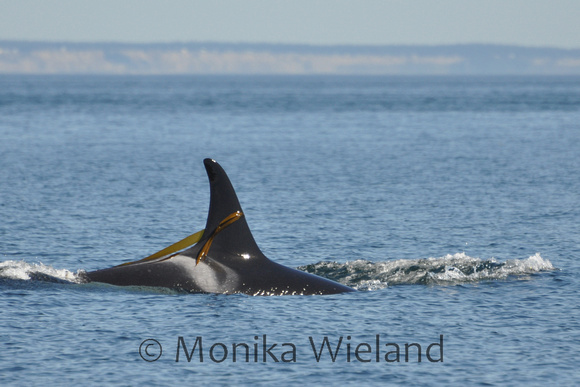 |
| J16 Slick kelping - prints of this photo available here |
Not to be outdone by her mother, J37 Hy'shqa surfaced with kelp, too - a lot more of it!
 |
| J37 Hy'shqa kelping - prints of this photo available here |
Behind the J16s were the J14s. J14 Samish was surrounded by all of her offspring. Here's a close-up look at Samish, who was what looks like black scribbles going through her saddle patch. I always think of Samish as having the most perfectly shaped dorsal fin. She always stands out to me:
 |
| J14 Samish - prints of this photo available here |
Samish's oldest son, J30 Riptide, is another big male in J-Pod. He surfaced here with Mt. Rainier visible in the distant background:
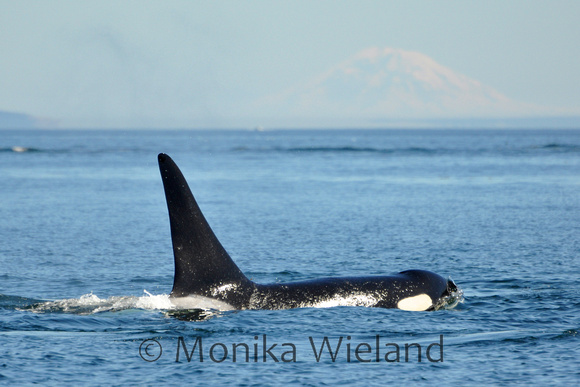 |
| J30 Riptide with Mt. Rainier in the background - prints of this photo available here |



